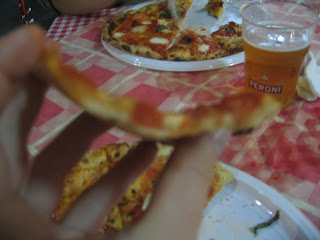
One of the first pizzas that I ate in Napoli was the pizza Mari. After tasting it I giggled to myself thinking, "oooh boy! Love at first bite!" My dorkish sentimentality was genuine. To me this is an indication of true love.
Mari is a white pizza. The ingredients are gorgonzola cheese, red or white onions, thinly sliced salame, fior di latte cheese, and burn spots.
I have noticed that the salted espresso lacks any real discussion on the value of burn spots. In telling you about my favorite pizza in the world I must also explain why burn is important. Sorbillo's pizza Mari is an excellent example of how to correctly utilize char.
The Mari is rich, too rich. Two cheeses, meat, and onions. By the time you've eaten half the pizza you fear that it will soon become too much. However, the char saves the day. Burn flavor cuts the richness of the cheeses and the meat. The pizza toes the line of too much flavor, too much creamy oily cheesiness, but char seizes the fragile flavor balance before it goes to far, suspending it just at the line. The char saves it, dangling it at the edge of perfection and too much.
As you work your way through this pizza you are in crisis. Can I finish this pie? Surprisingly, your stomach remains settled after each piece. The char eliminates the overpowering flavor that cheese and oil leave in the mouth in such a way sos to prevent you from ever feeling sick of it. It allows for the ingredients to show off their most delicious aspects while cutting down on the undesirable traits. The contrast between the sharp gorgonzola, the mellow gooey fior di latte, the salame so thin it becomes crunchy in the oven, and the sweet onions all dance around the mouth deliciously, but momentarily. The char keeps it all together, not letting one flavor overpower the others. The char maintains balance in a pizza dangerously close to the edge.
With each slice the crisis renews, but is always defeated by the char. As you finish the pie you do not feel too full or gross as you might with other rich foods. You feel good. The burn spots have been working in a third, invisible way. The following from wikipedia.org should explain what I mean.
"The porosity of charcoal accounts for its ability to readily absorb gases and liquids; charcoal is often used to filter water and absorb odors. Its pharmacological action depends on the same property; it absorbs the gases of the stomach and intestines, and also liquids and solids (hence its use in the treatments of certain poisonings)."
When I say 'char' of course I mean charcoal. The pizza Mari will not upset your stomach. Despite its rich toppings, the burn spots keep your belly settled, not only stopping the less than desireable flavor aspects from going too far in your mouth -the char sops up the extras in your belly so you don't get sick. Sweet.
These burn spots are the unsung heroes of Neopolitan pizza.
















